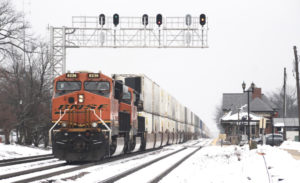
TRAINS: David Lassen
WASHINGTON — BNSF Railway has received a patent for a virtual track block system that has the potential to significantly boost existing mainline capacity, raise average train speeds, and improve the detection of broken rails.
The U.S. Patent and Trademark Office approved the patent application last month, and credits the invention to BNSF employees Mitchell Beard, Kent Shue, Jerry Specht, and Ralph Young.
The system would divide existing fixed-length physical track blocks into multiple virtual blocks. Train spacing would be reduced and would be based on train braking capabilities rather than the typical 2-mile length of a fixed signal block.
A moving block system essentially puts a safety envelope around trains, with distance between trains determined using real-time data on the speed, location, and braking performance of trains moving over the main line. By allowing trains to follow one another more closely, the capacity of a main line would be increased.
Moving blocks could boost the capacity of about 8,000 route-miles in the U.S., enabling railroads to avoid adding track and signals on main lines that are at capacity, according to a 2004 report on the benefits of positive train control that Zeta-Tech Associates prepared for the Federal Railroad Administration.
The report said moving block systems would be particularly beneficial on main lines where traffic moves at different speeds.
A moving block system would improve BNSF’s ability to pace its premium trains around slower moving freights. A high-priority Z-train, for example, could come up closely behind a merchandise train and then leapfrog ahead at quadruple-track crew change points such as Needles, Calif., and Amarillo, Texas.
The system also would eliminate the need for wayside signals.
“Among other things, the present principles alleviate the need for wayside signals, since train braking distance is maintained onboard the locomotives instead of through wayside signal aspects,” the patent summary says. “In addition, by partitioning the physical track blocks into multiple virtual track blocks, broken rail can be detected within an occupied physical track block.”
Fixed block signal systems have been in use for more than a century in North America. Various moving block systems have been used for years in Europe and Asia.
It was unclear when BNSF might begin testing and implementation of a moving block system or seek the required regulatory approval from the Federal Railroad Administration. The railroad did not respond to a request for comment.
“BNSF will have to file a safety analysis of its operating plan for moving blocks with FRA showing that there is no degradation of safety when it is implemented,” says signal expert Steve Ditmeyer. “FRA, in its recent revision of its regulations, has acknowledged that railroads may be considering removing their intermediate wayside signals, which is necessary for moving block operations, and that a safety analysis would be necessary.”
Studies have shown that moving blocks would result in about a 25% increase in capacity on single-track lines, but less than that on double-track routes, Ditmeyer says.














A maximum of a 25% increase on single track capacity?
Is that worth the expense and the loss of the reliability of signals?
Improving the right of way and decreasing dwell time is the best way to reduce time between point A and B.
wow, this will be something. But I will miss seeing the block signals. but can understand the reason for it. BNSF is on top of things, always partial to them because Frisco is part of their family. They kept the yard at St. Louis open where Dad worked and they run over tracks and bridges Frisco built. Can remember riding UP City of St. Louis on trips to CA and being in dome car at night and watch the overhead signals change from green to red just about the time the dome car passed under it. Whole new world.